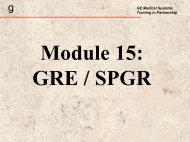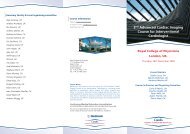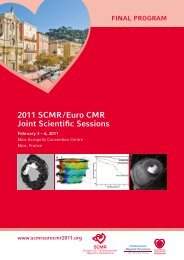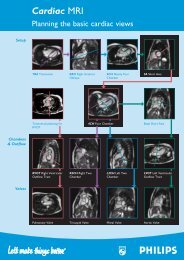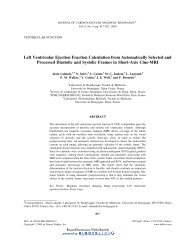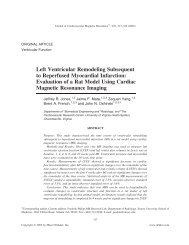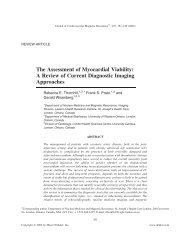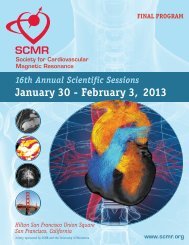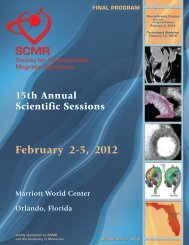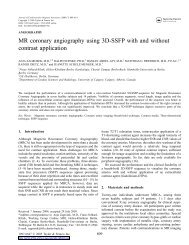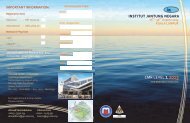Accurate and Reproducible Mitral Valvular Blood Flow Measurement
Accurate and Reproducible Mitral Valvular Blood Flow Measurement
Accurate and Reproducible Mitral Valvular Blood Flow Measurement
Create successful ePaper yourself
Turn your PDF publications into a flip-book with our unique Google optimized e-Paper software.
768 Westenberg et al.<br />
velocity-encoded MRI is a patient-friendly <strong>and</strong> easy-to-use method suitable for<br />
quantifying accurately <strong>and</strong> reproducibly the transvalvular MV flow.<br />
Key Words:<br />
processing.<br />
Magnetic resonance imaging; <strong>Mitral</strong> valve; <strong>Flow</strong> quantification; Image<br />
INTRODUCTION<br />
<strong>Accurate</strong> measurement of the transvalvular blood<br />
flow is invaluable for diagnosing patients with valvular<br />
disease. Currently, the assessment of mitral valve (MV)<br />
regurgitation or stenosis is based on echocardiography.<br />
Both two-dimensional transthoracic echocardiography<br />
(TTE) (Ascah et al., 1985; Goldman et al., 1987) as<br />
well as mono- <strong>and</strong> multiplane transesophageal echocardiography<br />
(TEE) with color Doppler (Caldarera et<br />
al., 1995; Helmcke et al., 1987; Shah et al., 1999;<br />
Spain et al., 1989) provide the information needed to<br />
plan surgical strategy (Hellemans et al., 1997; Miyatake<br />
et al., 1986). Quantification of transvalvular flow<br />
velocities based on Doppler measurements has to cope<br />
with two sources of error: the alignment of the<br />
ultrasound beam to the flow direction <strong>and</strong> the fixed<br />
location of the sample volume (Fyrenius et al., 1999;<br />
Sahn, 1988). Besides measurement restrictions, the<br />
interpretation of echo Doppler measurements to physiological<br />
parameters is achieved with the application of<br />
geometrical models, which do not apply to all<br />
individual subjects. <strong>Measurement</strong>s in multiple planes<br />
are necessary, which can yield a summation of errors.<br />
Furthermore, imaging the region of interest in TTE can<br />
be difficult or even impossible because of acoustic<br />
attenuation from structures inside the thorax (lungs,<br />
subcutaneous tissues, <strong>and</strong> ribs) <strong>and</strong> the heart (prosthetic<br />
valve construction materials <strong>and</strong> calcification). TEE is<br />
less limited by attenuation of thoracic structures, but<br />
this technique is semiinvasive <strong>and</strong> patients may experience<br />
discomfort during this investigation.<br />
Magnetic resonance imaging (MRI) is a noninvasive<br />
technique, which is readily applied for the determination<br />
of global <strong>and</strong> regional left ventricular<br />
anatomy <strong>and</strong> function (Van der Geest <strong>and</strong> Reiber,<br />
1999). As a three-dimensional (3D) imaging technique,<br />
volumetric measurements do not rely on the application<br />
of geometrical models. Velocity-encoded cine MRI<br />
provides quantitative information on moving spins <strong>and</strong><br />
can be applied to determine intra–ventricular blood<br />
flow (Mohiaddin, 1995; Van Dijk, 1984; Wigström<br />
et al., 1999). These promising qualities make MRI a<br />
very suitable modality for quantifying transvalvular<br />
blood flow. Previous attempts have all encountered<br />
the motion of the heart during contraction <strong>and</strong> relaxation<br />
as the main obstacle toward direct acquisition<br />
of the transvalvular flow. The mitral annulus moves<br />
12–16 mm toward the apex during contraction<br />
(Komoda et al., 1994).<br />
Kayser et al. (1997) showed that for tricuspid flow<br />
quantification, correction for through-plane motion is<br />
indispensable. This must also be considered for mitral<br />
flow. Their method corrects for through-plane motion of<br />
the right ventricular annulus in a retrospective manner.<br />
Since the acquisition plane has a fixed position during<br />
the complete cardiac cycle, the location of the data<br />
acquisition is not identical to the plane of the MV for the<br />
whole cardiac cycle. This implies that flow quantification<br />
does not represent the true transvalvular flow.<br />
Kozerke et al. (1999) introduced a single-slice acquisition<br />
for transvalvular aortic <strong>and</strong> MV-flow quantification<br />
adapted to the heart motion, the so-called<br />
‘‘STrack’’ technique. With this technique, accurate<br />
positioning of the acquisition plane enables measurement<br />
of the true valvular flow for all phases. Besides the<br />
fact that using this technique requires dedicated scanning<br />
software not widely available on all commercial<br />
MR scanners, this technique uses prospective triggering.<br />
This implies that the final part of the RR-interval will<br />
not be acquired <strong>and</strong> diastolic flow quantification,<br />
especially important at the MV, will not be accurate.<br />
Using velocity-encoded MRI, a new acquisition<br />
method is introduced in this study to obtain the<br />
velocity vector field of the intraventricular blood flow<br />
in three directions during the complete cardiac cycle.<br />
In this velocity vector field, the MV plane is indicated<br />
retrospectively. The velocity values of the vector<br />
components going through the MV plane will be reconstructed.<br />
For the MV area, this will result in an<br />
accurate MV flow measurement.<br />
MATERIAL AND METHODS<br />
MRI Acquisition<br />
Ten volunteers (9 males, 1 female, aged 33–67<br />
years, mean age 54±10 years) were recruited for MR<br />
examination, all without cardiac valvular disease as<br />
confirmed by TTE <strong>and</strong> TEE. The Medical Ethical<br />
Committee of our hospital approved all examinations.<br />
All volunteers gave informed consent. The MRI was<br />
performed on a 1.5 T scanner (ACS-NT15 Gyroscan



